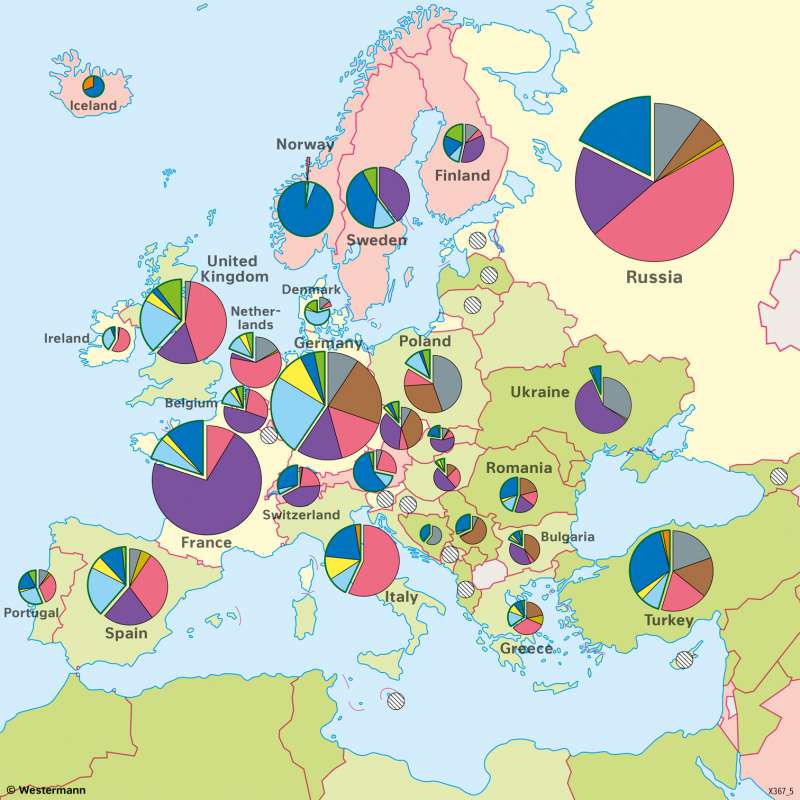Europe - Electric energy generation and consumption
Energy
978-3-14-100890-6 | Page 74 | Ill. 1

Overview
The most important European electricity producers are - in this order - France, Germany, the United Kingdom, Spain and Italy; in addition, Russia and Turkey generate some of their electricity outside Europe (see map). The combination of primary energies used for electricity generation shows some significant differences between the European countries. While the energy mix in countries such as Germany, Spain and Romania is relatively differentiated, in Poland, France, Serbia, Ukraine and the Netherlands, for example, individual primary energy sources dominate.
The necessary and urgent decarbonisation of the energy supply still seems to be quite far away. Not only is domestic coal still being burned to generate electricity, but a lot of coal is still being imported, as well as large quantities of natural gas (see figure).
Electricity mix and energy sources
The shares of primary energy used for electricity generation in the individual European countries depend, among other things, on the respective natural conditions, such as the availability of energy raw materials and the usability of hydropower. In countries such as Norway, Austria and Switzerland, for example, the potential for hydropower utilisation is particularly high due to the relief and the numerous rivers; this is reflected in the electricity generation. However, the pronounced use of hydropower also leads to seasonal fluctuations in electricity generation in the two Alpine countries. Electricity is therefore exported by Austria and Switzerland primarily in the water-rich summer months. While the exchange of electricity between Germany and Switzerland can certainly take place in both directions, electricity trade between Germany and Austria is predominantly in one direction: on most days of the year there is a clear export surplus of electricity generated in Germany.
Traditionally, most countries relied on their own deposits of conventional energy sources, for example Poland in the use of lignite and hard coal or Italy in the combustion of domestic natural gas. Germany's still high share of lignite in electricity generation is also striking.
Structures of the energy mix that cannot be justified (or can only be justified imperfectly by natural factors) are often due to energy policy frameworks. In Germany and other European countries, for example, the use of coal and above all nuclear energy became increasingly important under the slogan "away from oil and gas" after the so-called oil price crises of the 1970s. In Germany, the aim was to achieve a supply of electrical energy that was largely independent of the world market and at the same time cheap. Another example of the impact of framework requirements are Germany's decisions and strategies regarding the nuclear phase-out and the promotion of renewable energies. In the meantime, however, there are also ambitious plans by the European Union to massively restrict the use of fossil fuels for electricity generation.
France is the country that most obviously relies on the expansion of nuclear energy. The country obtains about three quarters of its electricity from nuclear power and can also export nuclear power to neighbouring countries.
Future developments on the electricity market will be largely determined by the strategies and measures with which the EU pursues its declared, only partially achieved goal of a European internal energy market and what results it achieves in the process. In addition, efforts to protect the climate are increasingly playing a decisive role. In countries like the United Kingdom, Italy or Denmark, the combustion of coal for electricity generation has already been massively reduced. In almost all European countries, the share of renewable energy sources for the generation of electricity has grown strongly in recent years.
The interconnected European electricity system
Electrical energy in Europe is transmitted and exchanged on a national and international level. This results in a complicated mosaic of exchange relationships, because electricity is purchased by suppliers where it is particularly cheap, for example, or where it is generated with a certain energy source (hydropower for green electricity).
The prerequisites for international electricity exchange processes are, among other things, uniform standards for grid technology, grid operation and electricity markets. This task has been performed by the Association of European Transmission System Operators (ENTSO-E) since 2009.




